Your cart is currently empty!
Search results for: “breastfeeding”
-
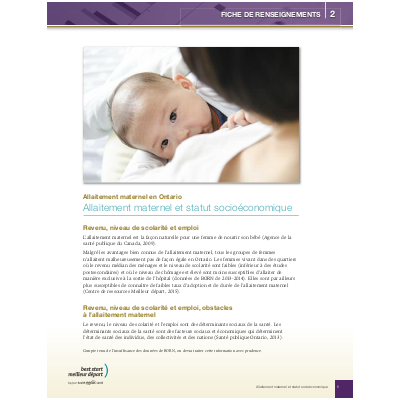
Allaitement en Ontario, fiche d’information no 2 : Allaitement maternel et statut socioéconomique
Part of a series of 5 fact sheets for service providers, exploring issues related to breastfeeding in Ontario, this particular fact sheets addresses the relationship between breastfeeding and socioeconomic status across the province.
Also available in English.
See also :
Fact Sheet 1: Notable Trends within the Province (in English and French)
Fact Sheet 3: Breastfeeding among Young Single Mothers (in English and French)
Fact Sheet 4: Breastfeeding Peer Support (in English and French)
Fact Sheet 5: Evaluating Breastfeeding Programs and Initiatives (in English and French) -
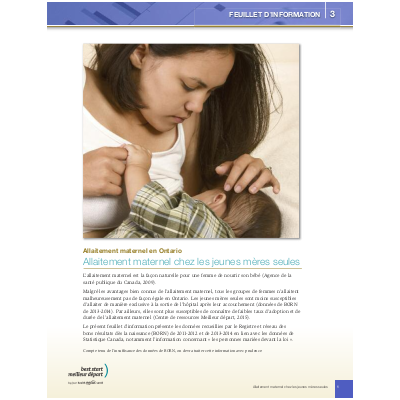
Allaitement en Ontario, fiche d’information no 3 : Allaitement maternel chez les jeunes mères seules
Cette fiche d’information fait partie d’une série de 5 fiches pour les prestataires de services, qui explorent plusieurs thèmes liés à l’allaitement maternel en Ontario. La fiche numéro 3 étudie l’allaitement maternel chez les jeunes mères seules à travers la province.
Également disponible en anglais.
Voir aussi :
Fiche d’information no 1 : Tendances notables dans la province (en français et en anglais)
Fiche d’information no 2 : Allaitement maternel et statut socioéconomique (en français et en anglais)
Fiche d’information no 4 : Programme d’entraide à l’allaitement maternel (en français et en anglais)
Fiche d’information no 5 : Évaluer l’efficacité des programmes et des initiatives en matière d’allaitement (en français et en anglais) -
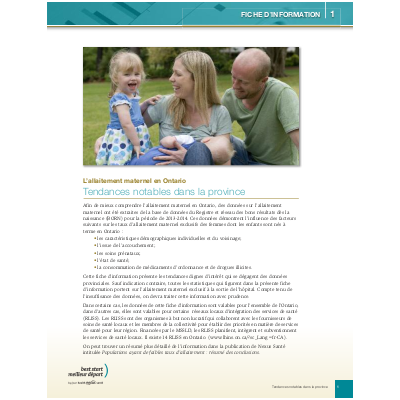
Allaitement en Ontario, fiche d’information no 1 : Tendances notables dans la province
Part of a series of 5 fact sheets for service providers exploring issues related to breastfeeding in Ontario, this particular fact sheet focuses on notable breastfeeding trends across the province.
Also available in English.
See also :
Fact Sheet 2: Breastfeeding and Socioeconomic Status (in English and French)
Fact Sheet 3: Breastfeeding among Young Single Mothers (in English and French)
Fact Sheet 4: Breastfeeding Peer Support: An Effective Strategy to Reach and Support Populations with Lower Rates of Breastfeeding (in English and French)
Fact Sheet 5: Evaluating Breastfeeding Programs and Initiatives (in English and French) -
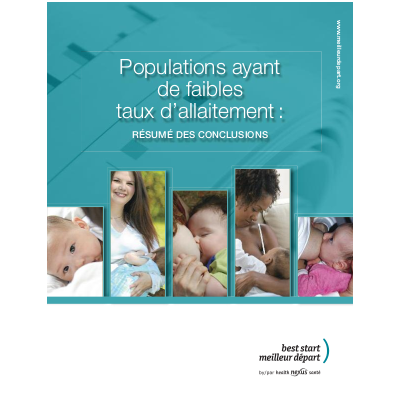
Populations ayant de faibles taux d’allaitement : résumé des conclusions
Bien que l’initiation de l’allaitement maternel en Ontario soit de 91.8%, il y a des populations qui ont de faibles taux d’allaitement. Le Centre de ressources Meilleur départ a terminé quatre stratégies de validation de la recherche pour confirmer les populations à faible taux d’allaitement maternel en Ontario ainsi que des stratégies d’allaitement qui sont efficaces auprès de ces populations. Le rapport qui en résulte met en évidence des informations sur les tendances en Ontario, les obstacles, les stratégies efficaces et prometteuses, et des recommandations pour atteindre les populations à faible taux d’allaitement maternel.
Également disponible en anglais.
-
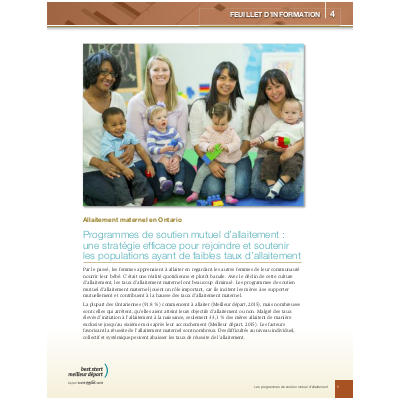
Allaitement en Ontario, Fiche d’information no 4 : Programme d’entraide à l’allaitement maternel, une stratégie efficace pour rejoindre et soutenir les populations ayant de faibles taux d’allaitement
Cette fiche d’information fait partie d’une série de 5 fiches pour les prestataires de services, qui explorent plusieurs thèmes liés à l’allaitement maternel en Ontario. La fiche numéro 4 étudie les programmes d’entraide à l’allaitement maternel à travers la province, et en quoi ils s’avèrent un moyen simple et innovant pour joindre et soutenir les groupes qui ont de faibles taux d’allaitement maternel.
Également disponible en anglais.
Voir aussi :
Fiche d’information no 1 : Tendances notables dans la province (en français et en anglais)
Fiche d’information no 2 : Allaitement maternel et statut socioéconomique (en français et en anglais)
Fiche d’information no 3 : Allaitement maternel chez les jeunes mères seules (en français et en anglais)
Fiche d’information no 5 : Évaluer l’efficacité des programmes et des initiatives en matière d’allaitement (en français et en anglais) -
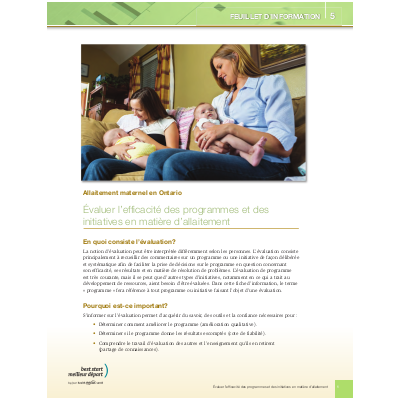
Allaitement en Ontario, fiche d’information no 5 : Évaluer l’efficacité des programmes et des initiatives en matière d’allaitement
Cette fiche d’information fait partie d’une série de 5 fiches pour les prestataires de services, qui explorent plusieurs thèmes liés à l’allaitement maternel en Ontario. La fiche numéro 5 évalue l’efficacité des divers programmes et initiatives liées à l’allaitement maternel à travers la province.
Également disponible en anglais.
Consultez les formulaires d’évaluation (format Word) qui ont été utilisés dans divers programmes et projets en allaitement maternel en Ontario.
Voir aussi :
Fiche d’information no 1 : Tendances notables dans la province (en français et en anglais)
Fiche d’information no 2 : Allaitement maternel et statut socioéconomique (en français et en anglais)
Fiche d’information no 3 : Allaitement maternel chez les jeunes mères seules (en français et en anglais)
Fiche d’information no 4 : Programme d’entraide à l’allaitement maternel (en français et en anglais) -

Allaitement en Ontario, fiche d’information no 2 : Allaitement maternel et statut socioéconomique
Cette fiche d’information fait partie d’une série de 5 fiches pour les prestataires de services, qui explorent plusieurs thèmes liés à l’allaitement maternel en Ontario. La fiche numéro 2 étudie le lien entre l’allaitement maternel et statut socioéconomique à travers la province.
Également disponible en anglais.
Voir aussi :
Fiche d’information no 1 : Tendances notables dans la province (en français et en anglais)
Fiche d’information no 3 : Allaitement maternel chez les jeunes mères seules (en français et en anglais)
Fiche d’information no 4 : Programme d’entraide à l’allaitement maternel (en français et en anglais)
Fiche d’information no 5 : Évaluer l’efficacité des programmes et des initiatives en matière d’allaitement (en français et en anglais) -

Allaitement en Ontario, Fiche d’information no 4 : Programme d’entraide à l’allaitement maternel, une stratégie efficace pour rejoindre et soutenir les populations ayant de faibles taux d’allaitement
Part of a series of 5 fact sheets for service providers exploring issues related to breastfeeding including trends in Ontario, this particular fact sheet focuses on how peer support can help address breastfeeding barriers for women in the province.
Also available in English.
See also:
Fact Sheet 1: Notable Trends within the Province (in English and French)
Fact Sheet 2: Breastfeeding and Socioeconomic Status (in English and French)
Fact Sheet 3: Breastfeeding among Young Single Mothers (in English and French)
Fact Sheet 5: Evaluating Breastfeeding Programs and Initiatives (in English and French) -
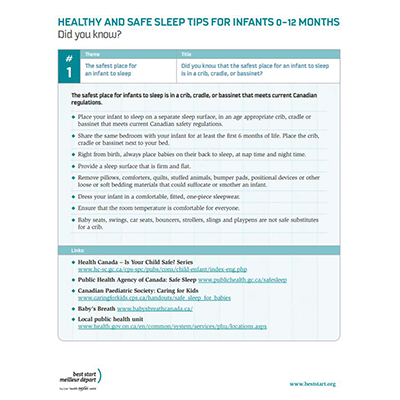
Infant sleep messages – Smoking and Sudden Infant Death Syndrome (SIDS)
This fact sheet is part of a series of 7 Infant Sleep Messages that provide tips and practical suggestions for parents and caregivers of infants aged 0-12 months on healthy and safe sleep. The tips support the current recommendations on how to reduce the risks of Sudden Infant Death Syndrome (SIDS) and other sleep-related causes of infant death. These messages are consistent with the information provided in the Sleep Well, Sleep Safe booklet (in English and French).
This particular tip sheets provides information about the risks of exposure to tobacco smoke during or after pregnancy on SIDS. It is also available in French.
How to use these tips:
- Share the tips through your Facebook pages.
- Send the tips via Twitter.
- Create links from your website to the tips.
- Print the documents and use them as handouts.
- Use the text in your parent newsletters.
Here are all the Infant Sleep Messages (available in English and French):
- The safest place for an infant to sleep : Did you know that the safest place for an infant to sleep is in a crib, cradle or bassinet?
- Attachment and sleep : Did you know that your infant needs your loving care to better develop healthy sleep habits?
- Establishing routines : Did you know that routines are important to help infants sleep well?
- Creating safe sleep environments : Did you know that creating safe sleep environments will reduce the risks of infant death?
- Breastfeeding and Sudden Infant Death Syndrome : Did you know that breastfeeding reduces the risks of SIDS?
- Alcohol/drug misuse and Sudden Infant Death Syndrome : Did you know that avoiding alcohol and drug misuse can reduce the risk of infant death?
- Smoking and Sudden Infant Death Syndrome : Did you know that preventing exposure to tobacco smoke, during pregnancy or after pregnancy, reduces the risk of SIDS?
-

Infant sleep messages – Alcohol/drug misuse and Sudden Infant Death Syndrome (SIDS)
This fact sheet is part of a series of 7 Infant Sleep Messages that provide tips and practical suggestions for parents and caregivers of infants aged 0-12 months on healthy and safe sleep. The tips support the current recommendations on how to reduce the risks of Sudden Infant Death Syndrome (SIDS) and other sleep-related causes of infant death. These messages are consistent with the information provided in the Sleep Well, Sleep Safe booklet (in English and French).
This particular tip sheets provides information on the risks of consuming alcohol or drugs during and after pregnancy on SIDS. It is also available in French.
How to use these tips:
- Share the tips through your Facebook pages.
- Send the tips via Twitter.
- Create links from your website to the tips.
- Print the documents and use them as handouts.
- Use the text in your parent newsletters.
Here are all the Infant Sleep Messages (available in English and French):
- The safest place for an infant to sleep : Did you know that the safest place for an infant to sleep is in a crib, cradle or bassinet?
- Attachment and sleep : Did you know that your infant needs your loving care to better develop healthy sleep habits?
- Establishing routines : Did you know that routines are important to help infants sleep well?
- Creating safe sleep environments : Did you know that creating safe sleep environments will reduce the risks of infant death?
- Breastfeeding and Sudden Infant Death Syndrome : Did you know that breastfeeding reduces the risks of SIDS?
- Alcohol/drug misuse and Sudden Infant Death Syndrome : Did you know that avoiding alcohol and drug misuse can reduce the risk of infant death?
- Smoking and Sudden Infant Death Syndrome : Did you know that preventing exposure to tobacco smoke, during pregnancy or after pregnancy, reduces the risk of SIDS?